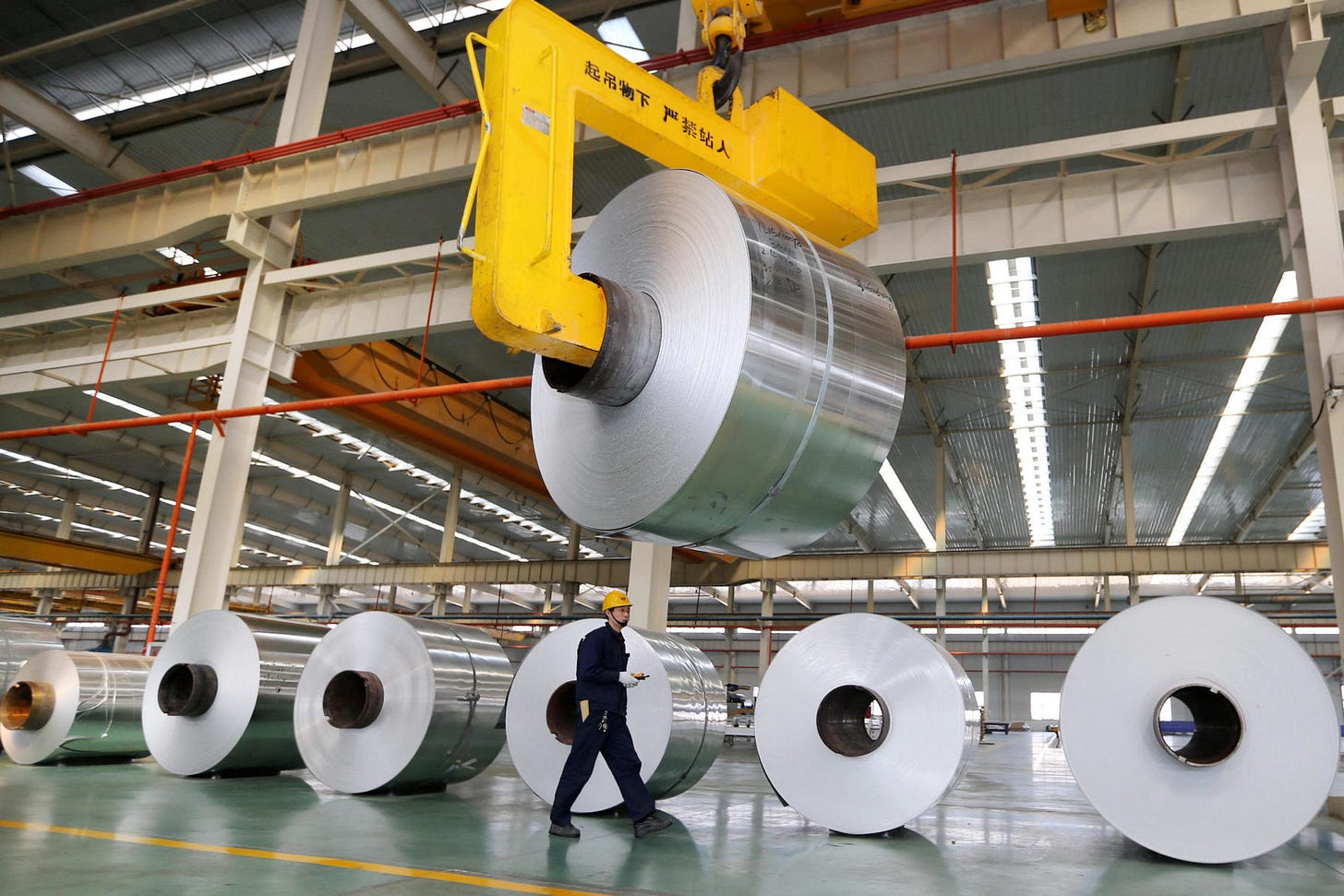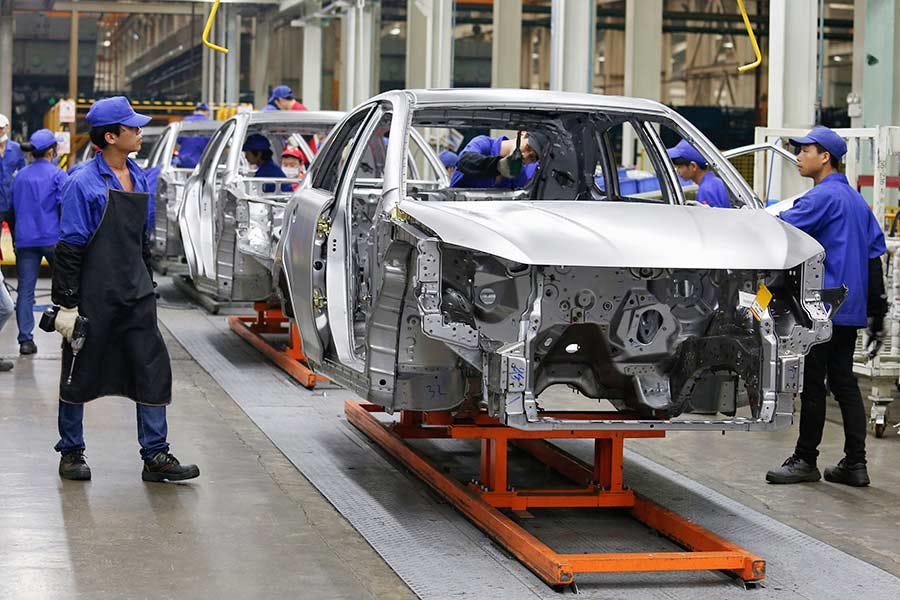How China's carbon-intensive heavy industry powers its clean tech industry
China's heavy industries like steel and aluminum are a huge emissions problem. Yet, they also provide key inputs into China's clean tech sector, like EVs, solar panels, and wind turbines.
China’s carbon heavyweights
China dominates much of global heavy industry, producing more than half the world’s steel, aluminum, cement, and petrochemical products. According to IRENA: “The energy consumption of these industries accounts for around 60% of the country’s gross final energy use.” Coal, which is around 60% of China’s electricity supply, is a key energy source and ingredient for China’s heavy industry. Industry in general (not just heavy industry) makes up roughly 40% of China’s GDP and 26% of China’s total emissions. China’s steel industry alone accounts for more than 15% of China’s total emissions and roughly 5% of global emissions.
China has been making efforts to reduce the carbon impact of its heavy industry. One strategy has been to try to reduce production. China has imposed national caps on steel and aluminum production. More recently, a shortfall in hydropower generation due to droughts led China’s grid operators to urge aluminum producers to reduce production in affected provinces like Yunnan.
But efforts to limit production have faced obstacles that are deeply embedded in China’s political economy. Steel overproduction has been a problem that China has been trying to address since the early 2000s. China’s provincial governments are reluctant to limit project approvals and subsidies for steel production within their jurisdictions for fear of losing jobs and revenue as well as missing GDP targets. Moreover, when steel mills get shut down, they can take as long as 6 months to restart, so keeping them running can feel like a safer bet. Even as prices plummet and steel mills become unprofitable, provincial governments continue to invest in steel production. While crude steel output has declined since 2021, China has invested around $100 billion in new coal-based iron and steel capacity over the same period.
(In the CREA chart below, the shaded region shows steel production, which has dropped off a bit since 2021. The green line shows investment remaining high, even as the purple line shows profits slipping below zero.)
A similar dynamic with overcapacity has been playing out with China’s petrochemicals industry. The shift from traditional gas-powered cars to electric vehicles has caused China’s oil refiners to shift toward petrochemicals. Even as prices for petroleum products like ethylene and propylene have dropped, Chinese oil refiners are reluctant to shut down production for fear of losing market share and realizing short-term losses. The resulting surge in Chinese petrochemicals production has more than offset a decline in China’s other sources of oil demand. A recent IEA commentary described the global impact of this shift: “Were it not for the sector’s rapid growth, total oil consumption would remain comfortably short of the pre-pandemic mark.”
Another strategy has been to make China’s heavy industry production more carbon-efficient. While the vast majority of China’s steel is currently produced with coal-based furnaces, China is making a push towards low-carbon electric arc furnaces (EAF), which are expected to make up over 17% of China’s steel capacity by the end of 2024. In aluminum, China is trying to decarbonize the electricity supply by shifting aluminum production closer to renewable energy sources and shifting electricity supply from captive power to the grid, which itself is decarbonizing over time. China’s overarching approach is to push on all fronts and try to both lower production and improve carbon efficiency, with more success with the latter so far.
China’s heavy industry powers its clean tech industry
While China’s heavy industry contributes significantly to China’s emissions, it also plays a crucial role in China’s clean tech industry. In fact, China’s growing clean tech industry is already starting to affect demand for industrial commodities like steel and aluminum. Let’s look at some “concrete” examples.
Electric vehicles
Electric vehicles rely on a lot of aluminum. Aluminum’s properties as a lightweight yet strong material with good thermal conductivity make it the ideal material for a wide range of EV parts, including vehicle frames, wheels, electric motors, batteries, and battery enclosures. Aluminum is also increasingly being used for EV chassis as manufacturing innovations like gigacasting allow large components to be made as a single continuous piece (as I’ve written about). Overall, plug-in hybrids (PHEVs) and full battery electric vehicles (BEVs) tend to use around 25% more aluminum than traditional gas-powered cars due to its lightweight properties, and the EV industry has already increased global demand for aluminum. (In Chinese, this industry trend towards making vehicles more lightweight to improve battery range is called 轻量化 or “lightweighting” in the broader industry.)

Chinese EV makers benefit from access to China’s vast aluminum industry, which makes up more than half of global production. This helps lower material costs, which are a significant factor in keeping overall costs low. And Chinese EV makers benefit from being able to work directly with producers of aluminum and aluminum products to develop specialized alloys and ensure stable supplies. Chinese state automaker SAIC partnered with Chinese state-owned Chalco, the world’s largest aluminum producer, to “jointly develop technologies to apply new aluminum materials to automobile parts.” BYD benefits from its close relationship with its top supplier for battery enclosures, Chongqing-based New Aluminum Era (新铝时代).
China’s EV industry benefits in other ways from China’s dominance in heavy industry. EV parts like windows, seats, door panels, and bumpers are typically made from petrochemical products, like fiberglass. According to a Chinese energy expert, “each NEV uses at least 100 kilograms more plastic than a traditional fossil fuel-powered vehicle. To manufacture lighter-weight NEVs in the future, the use of more plastics is required to replace metals, and that relies on oil for the production of plastics.” EV charging infrastructure also requires similar heavy industry commodities, like steel, aluminum, and cement. EV factories themselves require a lot of specialized metal alloys, such as for industrial robots and machine tools.
Wind and solar
The construction of wind and solar plants relies on large amounts of heavy industry commodities, like steel and aluminum. According to analysis by BloombergNEF, solar requires around 33 tons of steel and 15 tons of aluminum for every megawatt of output. Wind farms use steel for “the structural tower itself, the house of the turbine, the turbine blades, plus electrical steels for electricity generation.” Offshore wind farms require even more steel (90% of total materials) for foundations that reach down to the ocean floor. Steel and aluminum are also essential materials for the extra electricity transmission and storage infrastructure needed to smooth out regional distribution and intermittency issues with wind and solar.
China’s heavy industry can also help its solar and wind industries in less obvious ways. One of my favorite examples of industrial policy spillovers is the connection between steel, shipbuilding, and offshore wind. China’s heavily state-supported steel industry benefits its heavily state-supported shipbuilding industry, which makes up over half of global shipbuilding. China’s vast shipbuilding industry, in turn, allows it to make highly specialized, supermassive offshore wind turbine installation vessels (WTIV) that are large enough to transport and install wind turbine blades that can stretch over 100 meters. Of the WTIVs under construction, close to 90% are being made in China.

China’s strength in steel and shipbuilding also helps it build specialized roll-on, roll-off (RORO) car-carrier ships for exporting Chinese EVs around the world. Chinese EV makers such as BYD have already launched their own car-carrier ships to transport thousands of vehicles to markets like Europe and Brazil. Of course, this same shipbuilding capacity supports not only clean tech industries but also fossil fuels as well, such as the new fleet of 18 LNG carriers that Qatar recently commissioned from China State Shipbuilding Corporation (CSSC).
The flip side of the argument
Of course, you could flip the framing of this whole topic and argue that China’s clean tech industries are actually built on dirty industries. This is a fair point. The elephant in the room is China’s heavy reliance on coal for both industrial production and electricity generation—60% of China’s electricity supply comes from coal, as I mentioned at the beginning.
Take China’s high-speed rail system. Researchers estimate that China’s electric high-speed trains reduce China’s annual transportation emissions by slightly over 1%. This seems almost surprisingly low until you consider the high emissions cost of the construction materials like steel and cement as well as the large share of electricity generated from coal. (Interestingly, the emissions reductions for China’s HSR don’t come from shifting passengers from road to rail travel but rather from greater rail freight capacity freed up by the passenger-only HSR lines. This is even greater than the emissions reductions from the shift away from airline flights.)

China’s reliance on coal also complicates the EV story. A BloombergNEF analysis looking at lifecycle emissions found that while EV manufacturing is actually higher emissions than traditional gas-powered cars, over time the lower operating emissions of EVs makes up for this. What’s surprising is that for China, the breakeven point is closer to 10 years due to China’s coal-heavy electricity mix. But this will likely improve as China’s overall electricity generation shifts to clean energy.
The heavy industry and clean energy virtuous cycle
Looking ahead, we can see a virtuous cycle forming between China’s heavy industry and its clean tech sectors. China’s heavy industry enables the production of EVs, solar panels, wind farms, power lines, and batteries. As these clean tech products come online, they help decarbonize heavy industry, shifting production towards “green steel” and low-carbon aluminum. Some parts of this process might be harder to improve. You can only reduce fossil fuel use so much in an industry like petrochemicals where by definition everything is made from oil and natural gas.
The biggest factor in whether China can keep up this virtuous cycle is China’s commitment to trying to decarbonize its heavy industry in the face of resistance from established players and not insignificant transition costs. But of course, there are much bigger costs to not forging ahead with decarbonization, both to China and to the entire world.
More reading:
Nature article on the emissions impact of China’s high-speed rail system
South China Morning Post: PetroChina: rapid EV uptake means oil consumption for transport to peak by next year ‘at the latest’ in China








